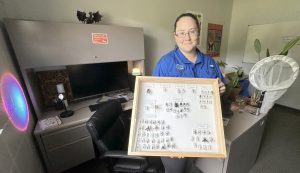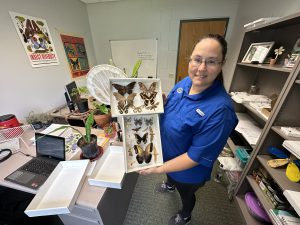
Q: How did you hear about UF/IFAS Indian River Research and Education Center?
A: I was doing a bachelor’s degree at Indian River State College, and I needed an internship. An entomology internship popped up with Dr. Patricia Prade (UF/IFAS-IRREC Ph.D. Graduate, 2021), as the supervisor. The internship was here, at the UF/IFAS Indian River Research and Education Center at the Norman C. Hayslip Biological Control Research and Containment Laboratory. After completion of the internship, I participated in a capstone project for my bachelor’s degree with Dr. Carey Minteer. My BSc degree capstone was a competition experiment between Brazilian peppertree (Schinus terebinthifolia) and two native shrubs, buttonbush (Cephalanthus occidentalis) and shepherd’s needle (Bidens alba). We grew the Brazilian peppertree and native shrub together, 1-1, to see which would outcompete the other in terms of growth. Interestingly, shepherd’s needle outcompeted the Brazilian peppertree. Shepard’s needle is a native Florida plant and is a common weed. It’s most often found in gardens and yards and places where the soil has most recently been disturbed.
After my bachelor’s capstone was complete, I became a laboratory technician for Dr. Minteer and enrolled in a master’s degree entomology program with UF. My advisor is Dr. Jaret Daniels in Gainesville. Because my work location is here in Fort Pierce, Dr. Carey Minteer is a co-advisor. My third committee member is Dr. Adam Dale, an entomology department faculty member in Gainesville.
Q: You are pursuing a Master of Science degree in Entomology. When did you become interested in entomology?
A: I had at first wanted to pursue neuroscience. After the internship and capstone, I find insects to be fascinating little creatures. All the intricate relationships insects have with plants and with each other are truly mind blowing. It’s cool. I love this place. Dr. Minteer is an outstanding supervisor. She is hands on and allows her students to pursue their passions.

Q: Can you elaborate on your interests in monarch butterflies? Please begin with the most basic information and move to the most complex.
A: Multiple populations of monarch butterflies can be found in the United States. The most famous are the two migratory populations. The Eastern migration goes from Mexico all the way up the Eastern seaboard to Canada and then back again. The Western migration goes from breeding sites in California to feeding sites just west of the Rockies and then back to California. There are also some populations that don’t migrate, found mostly along the southeastern coast. It is thought that the monarch population south of Lake Okeechobee fell out of migration. For the most part, these butterflies will not return to a migratory status. They’re here to stay.
A lot of research has been done to determine why the butterflies have decided to stay local. Much of it has to do with our warm subtropical climate – it’s nice and cozy for the butterflies. Another driver is the year-round supply of food supplied by tropical milkweed in home gardens. The migration is perfectly timed to follow the life cycle of the host plant. Milkweeds that are native to North America die back in the fall, and that serves as a cue for the butterflies to move on. Tropical milkweed does not die back, so the monarchs decide to stay and take advantage of the ample food source.
Q: Please elaborate on the different species of milkweeds.
A: We have native milkweeds, those that have been around for a long time, which are good for butterflies. There are over 100 species of milkweed in the country and 21 in Florida. Of those 21 milkweeds native to Florida, only three are easily cultivated and sold in specialist nurseries. There’s butterfly weed (Asclepias tuberosa), pink swamp milkweed (Asclepias incarnata), and white swamp milkweed (Asclepias perennis). They are tough for the average gardener to grow because they have strict growing requirements. We bring in a lot of fill dirt which makes it tough to cultivate the native milkweed. So, people will buy tropical milkweed because it’s fast and easily accessible in big-box stores.
Additionally, and more importantly depending on who you ask, tropical milkweed is now a “species of concern” in south Florida, which means it is potentially invasive. It grows extremely well in Florida pastures and has been found extensively in natural areas.
Q: Why do people plant tropical milkweed and is there a problem with the plantings?
A: People plant tropical milkweed because they try to help monarchs. Because monarchs are attracted to tropical milkweed, Floridians believe it is good for the butterflies. And in doing so, that’s pulling monarchs out of migration, and that isn’t good. When the monarchs stay here in Florida, they are more vulnerable to a parasite called OE, Ophryocystis elektroscirrha, which clings to the monarchs’ wings and body. This parasite’s entire lifecycle is on the monarch. The OE’s spores are all over the monarch. When the monarch flaps its wings, the OE spores fall wherever it flies. When a female monarch lays her eggs, OE spores are all over the egg. As soon as the caterpillar comes out, it eats the egg casing and in doing so it ingests some of those spores. Then it goes on to eat the plant and ingests more of the spores. At first, the parasite reproduces slowly in the caterpillar’s gut, and then when the caterpillar goes into its chrysalis, the spores explode in population. And when the butterfly comes out, sometimes with crumpled wings. It won’t be able to fly. The monarchs have decreased fitness and some of them die. It is very bad, and studies have shown resident populations are upwards of 99% infected in Florida, compared to the migrating populations in other areas. The migration acts as a protective measure against the parasite OE because the butterflies can escape the OE. Only the butterflies that are fit to migrate will move on and reproduce, which leaves out the butterflies that have the OE spores. When Floridians plant tropical milkweed they encourage a resident population that cannot escape.
.
There is a great blog by Dr. Andy Davis, a prominent monarch scientist, which goes into the research. Dr. Davis does a wonderful job diving into the literature and writing about it in layman’s terms so everybody can understand it. Here’s the link if anyone is interested: https://www.monarchscience.org/ or link here.
Q. What are your objectives for your research thesis?
A. I have three research questions.
1. The first question is related to oviposition preference. That’s the preference the female has for laying eggs on specific plants. I am going to test four different milkweed species: pink swamp milkweed, tropical milkweed, giant milkweed, and balloon milkweed. Since tropical milkweed has been getting some bad press and very little research has been done on balloon milkweed and giant milkweed, these species are becoming more popular. But they may have the same effect on migrating butterflies because they are evergreen. Balloon and giant milkweed maintain a food source here year-round. The monarchs come and see plenty of food, they lay their eggs and they stay. And so, I want to know are these two milkweeds going to have a similar effect on the oviposition preference of monarch butterflies?
2. The second question for my research is related to larval performance and larval development on those four milkweed species to see if their measurements are different. The time that an insect takes to develop is dependent on temperature. But the quality of food can determine how fit they are when they become butterflies. We will look at larval development, wing development, and check them for OE spores.
3. The third question is where it gets a bit tricky. I want to get the cardenolide profiles of the milkweed plants. Cardenolides, also known as cardiac glycosides, are a secondary compound produced by plants for defense. And there is an evolutionary arms race between plants and insects. There always is. And so, some insects can take those compounds and sequester them into their bodies to act as defense for predators, which is what the Monarchs do. That’s why Monarchs are bright orange. That’s their aposematic warning to predators that, “if you eat me, you will have a bad time.” It produces a strong vomiting response. Some cardenolides are more potent than others. There are different types of cardenolides. Cardenolide characteristics for every type of milkweed species are different. And even within the species, individual plants are different. So, I want to dig into that. It’s a lot of chemistry. It’s interesting. We will have to do chromatography.
Q: What are your plans after you complete your master’s degree?
A: I would like to do a federal job because it will stack with my military service. Ideally, I want to work with the national park service and conservation of insects. Plants and animals have a lot of voices helping them, but insects don’t because people don’t care as much about them. To the public, they’re creepy crawlies, strange creatures appearing more alien than animal. People don’t realize just how important insects are to the entire planet. I want to help insects anywhere I can because their populations are declining, and if they go, we go.
A video featuring Sheri Holmes for Graduate Student Appreciation Day
 6
6
